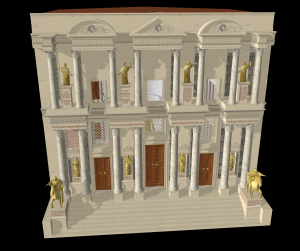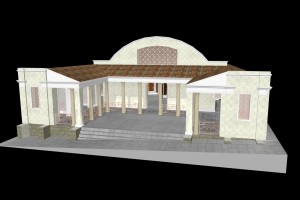My interest in digital reconstruction started with making models of Roman public libraries to illustrate my DPhil thesis. Since then I have used these models and others like them to illustrate various talks and papers, and some of them have found their way into print in academic and popular publications. I use them in my Classics research and teaching at Reading and in my classes at the London Rare Book School.
One of the best preserved libraries of the Classical world is the handsome library of Celsus at Ephesus. Its ebullient baroque facade fell down in an earthquake and was painstakingly re-erected by Austrian archaeologists in the twentieth century, but the facade statues are missing, the doors are gone, and the remains of the book room behind are less well preserved.
A digital reconstruction seemed like a good way of filling in some of these elements. Here is a still image and fly-in movie:
Celsus library flyin – movie
Other libraries in the Roman world that I have reconstructed include the charming little library at Timgad, with its forecourt and hemicyclical book room. I have published on this and the Ephesus library, suggesting that their prominent locations and elaborate architectural address to the passing public are part of their designed function.
I’ve also made a model of the ruins at Timgad and it’s possible to fade between this and the reconstructed model to show how one informs the other. This, I hope, is a good illustration of the potential of architectural modelling for showing the current and reconstructed states of a building, and for allowing virtual access to a site (in Algeria) that can be difficult and sometimes dangerous to get to.
These models proved useful to me and led to my current large-scale project to reconstruct the whole of the city of Rome – a city which included, by the age of Constantine, 28 libraries.
SaveSave
SaveSave




Very good model of what the library might have looked like! Thank you
Thanks! Glad you liked it. I am about to have published a little article about this in the British Universities Film and Video Council (BUFAVC) magazine Viewfinder, illustrated with a picture of this model. That should be available on line within a week or so if you would like to look for it.
Thanks!
Hello !
HD is available in the library?
It would be good
I don’t have an HD version of this video yet – when I make one, I’ll post it here.
Very interesting work. Bravo!
this article is very useful, thank you for making a good article